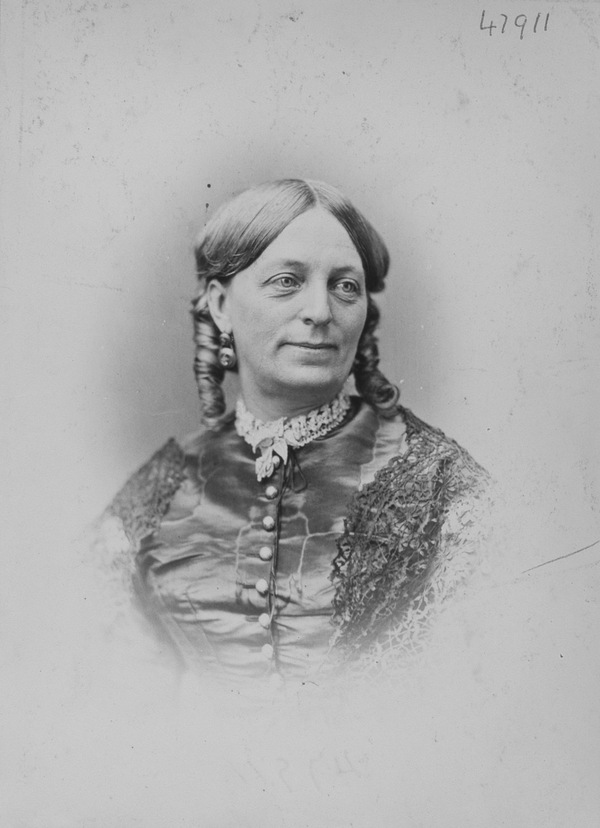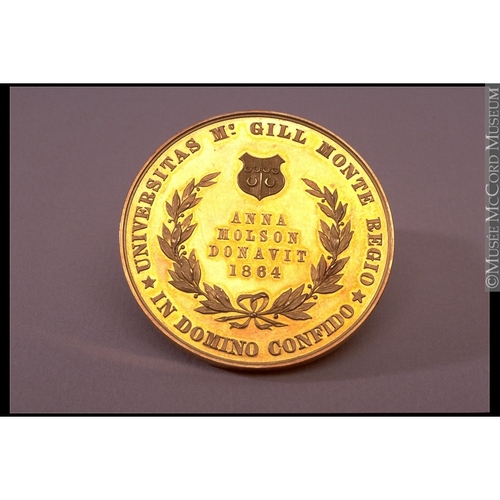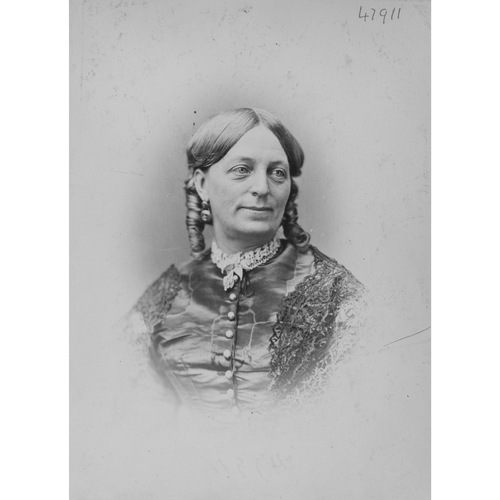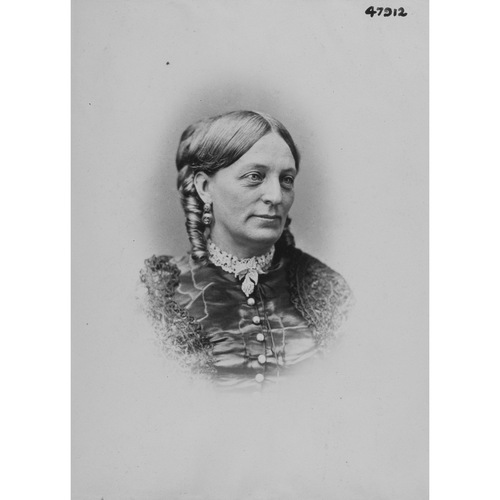
Source: Link
MOLSON, ANNE (Molson), philanthropist; b. 8 April 1824 at Quebec, third child of William Molson* and Elizabeth Badgley; d. 3 Jan. 1899 in Atlantic City, N.J., and was buried in Montreal.
Anne Molson was born into a family that was at the forefront of many major economic and technological changes in Lower Canada and was involved in industry, banking, philanthropy, education, and politics. Her father was determined that his children would be educated as “amply and respectably as the country will afford.” He was prepared to have his son’s education completed in Britain, but there was no suggestion that such effort should be made for his daughters, Anne and Elizabeth Sarah Badgley. On 9 June 1845, Anne, then 21, married her 25-year-old first cousin John Molson, son of John Molson* Jr. Whether the marriage had been engineered by the fathers is not clear, but it had the happy result of keeping the money in the family. William was to provide more than £300 annually towards the maintenance and support of the couple; Anne was to control more than £50 of this. Moreover, because her goods were to be considered separate from her husband’s, she had, in principle, more rights over her money than did the vast majority of women married under a community of property. Her husband explicitly granted her “every necessary power and authority for the free and absolute administration” of her property. Within eight years Anne gave birth to five children, of whom three survived childhood. In 1860 her father-in-law died, leaving Belmont Hall, his home on Rue Sherbrooke, Montreal, to John. Anne became mistress of this country-like mansion, with its extensive brick and stone stables, large gardens, and impressive circular drive.
Once her children were old enough to go to school, Anne had time to develop other interests. In 1864, initially pretending to act on behalf of a male acquaintance, she proposed to her good friend Principal John William Dawson of McGill College the donation of a medal. She gladly accepted his recommendation that it be offered to the best student in physics, mathematics, and physical science. She chose its design and, at her father’s insistence, it was called the Anne Molson Gold Medal. Perhaps the irony of honouring the best student at a university that did not admit women was not lost on her. Pressure began mounting in Montreal to have McGill open its doors to women. In the summer of 1870 Dawson and his wife, while visiting Britain, collected information on higher education for women. On their return they drafted a detailed proposal for an organization modelled on the Ladies’ Educational Association of Edinburgh. As a result, on 10 May 1871 many of the leading English-speaking female bourgeoisie met at Belmont Hall to form the Montreal Ladies’ Educational Association. All officers and members were to be women (except the treasurer, who had to be a man, and honorary male members); Anne was elected president and her husband treasurer.
Regretting the lack of public education for girls that would serve as a foundation for higher education, the association organized courses – given by professors from McGill – which would pave the way for an academic degree. It also projected the establishment of a women’s college at McGill. The association’s classes began in 1871. Initially French literature, English language and literature, and natural philosophy were offered; to them would be added astronomy, logic, chemistry, physiology, and many other topics. The founders were determined at first that the courses should not become “merely popular,” but the later addition of nutrition, cooking, and domestic surgery and nursing suggests some reorientation towards what were seen to be subjects of special interest to women.
Anne’s action in helping to found the association may have been inspired by an abstract belief in the rights of women, but her primary motivation was more basic: like many members of the executive, she enrolled her daughter, Edith, in the lectures and she followed some courses herself. The women of the association found that, even when they themselves did not take courses, their daughters’ involvement enabled them “to keep their interest fresh in the work, and not fall quite behind in the race for knowledge.” This aspect of Anne’s contribution was cruelly shattered when Edith died in September 1872 at age 19. Grief and ill health subsequently curtailed Anne’s involvement in the association, and in December 1873 she resigned as president. The committee stressed that to her energy and discretion were due “almost the existence and much of the prosperity of the Association.” Made an honorary life member and vice-patroness, she continued to attend meetings sporadically.
The Ladies’ Educational Association met for the final time, with Anne in the chair, in 1885; the previous year women had been admitted to McGill. Anne steered through a vote of thanks to Dawson for his lecture series, advice, and “unvarying interest.” The two had perhaps collaborated on more than the lectures. As early as 1881 Dawson had talked to Anne about funding courses for women at McGill. She had replied in June that were it “in my power how gladly would I aid . . . but . . . I am not my own mistress to use money as I would, so I can at present only give you my most earnest prayers.” She may have done more, however, for in 1884 Donald Alexander Smith*, a friend of the family, unexpectedly donated the money necessary to admit women.
Anne was also involved in various Montreal charities, including the Montreal Ladies’ Benevolent Society and the “Maternity,” and she was an honorary president of the Montreal Society of Decorative Art. Anglicans, she and her husband were instrumental along with three others in organizing St Martin’s Church.
Anne Molson died “rather suddenly” in early January 1899, a few days after leaving Montreal for a holiday in Atlantic City. As a Molson, she had adopted some of the family’s interests and concerns and shared in the material and social benefits that wealth and standing offered. However, as a woman in a family and a society that viewed her position as secondary, she could pursue publicly only those interests to which women were restricted. Although she made important attempts to broaden horizons for middle-class women, Anne Molson was constrained by limits on her sex, and she quietly resented those constraints.
[Anne Molson did not leave a diary and there is almost no mention of her in the voluminous Molson family archives (NA, MG 28, III 57). Her personal life can be sketchily reconstructed from parish records, notarial archives, and the census records for the city of Montreal. b.b.]
ANQ-M, CE1-63, 27 avril 1846; 2 août, 17 nov. 1847; 25 août 1851; CN1-175, 7 juin 1845. ANQ-Q, CE1-61, 28 avril 1824. McGill Univ. Arch., MG 1022; MG 1053. NA, MG 28, III 57, 22: file 28; RG 31, C1, 1861, 1871, 1881, Montreal. Handbook for the city of Montreal and its environs . . . (Montreal, 1882). Margaret Gillett, We walked very warily: a history of women at McGill (Montreal, 1988). S. E. Woods, The Molson saga, 1763–1983 (Scarborough, Ont., 1983).
Cite This Article
Bettina Bradbury, “MOLSON, ANNE (Molson),” in Dictionary of Canadian Biography, vol. 12, University of Toronto/Université Laval, 2003–, accessed December 31, 2025, https://www.biographi.ca/en/bio/molson_anne_12E.html.
The citation above shows the format for footnotes and endnotes according to the Chicago manual of style (16th edition). Information to be used in other citation formats:
| Permalink: | https://www.biographi.ca/en/bio/molson_anne_12E.html |
| Author of Article: | Bettina Bradbury |
| Title of Article: | MOLSON, ANNE (Molson) |
| Publication Name: | Dictionary of Canadian Biography, vol. 12 |
| Publisher: | University of Toronto/Université Laval |
| Year of publication: | 1990 |
| Year of revision: | 1990 |
| Access Date: | December 31, 2025 |






